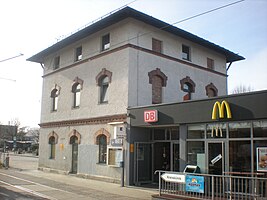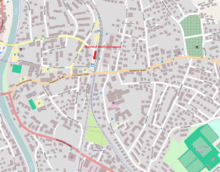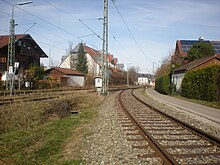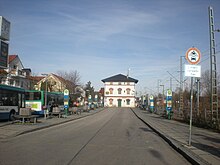Wolfratshausen station
| Wolfratshausen | |
|---|---|
|
Entrance building from the track side
|
|
| Data | |
| Design | Through station |
| Platform tracks | 2 |
| shortcut | MWO |
| Price range | 6th |
| opening | July 27, 1891 |
| Website URL | Station database of the BEG |
| Profile on Bahnhof.de | Wolfratshausen |
| location | |
| City / municipality | Wolfratshausen |
| country | Bavaria |
| Country | Germany |
| Coordinates | 47 ° 54 '51 " N , 11 ° 25' 37" E |
| Height ( SO ) | 576 m above sea level NHN |
| Railway lines | |
|
|
| Railway stations in Bavaria | |
The Wolfratshausen Station is an operating agency of Isartalbahn in the Upper Bavarian town of Wolfratshausen . The station is in the tariff area of the Münchner Verkehrs- und Tarifverbund (MVV) and is served by the S 7 line of the Munich S-Bahn .
The Lokalbahn Aktien-Gesellschaft (LAG) put the station into operation on July 27, 1891 as the end point of the Isar Valley Railway coming from Munich . On June 1, 1897, the LAG extended the Isar Valley Railway to Eurasburg and later to Bichl . Until the nationalization of the LAG in 1938, Wolfratshausen was a locomotive station where locomotives were serviced. From 1957 to 1972 the Deutsche Bundesbahn shut down the line between Bichl and Wolfratshausen in several stages, since then the Wolfratshausen station has been the terminus of the operated line again. S-Bahn traffic between Munich and Wolfratshausen was started in May 1972 .
location
The train station is located in the east of Wolfratshausen city center . The station building is to the west of the tracks and has the address Bahnhofstraße 41. To the west of the tracks are Bahnhofstraße, Sauerlacher Straße and Am Floßkanal. The Wolfratshausen bus station is located south of the reception building . In the southern area of the station, Sauerlacher Strasse ( Staatsstrasse 2070 ) crosses the tracks with a level crossing , while Mühlpointweg crosses under the line to the north of the station.
Wolfratshausen is today the end point of the Isar Valley Railway ( VzG 5507), a single-track, electrified main line . The station is at the 26.30 kilometer. The railway line is managed by the Deutsche Bahn as course book route 999.7.
story
Planning and construction
On October 24, 1886, the Bavarian state granted the concession to build a meter-gauge railway line from Munich via Wolfratshausen to Rottmannshöhe on Lake Starnberg , which, according to a resolution of 1885 , was to be built in standard gauge . The Wolfratshausen train station was to be built near the Dorfener Höhe, which was about three quarters of an hour's walk from the Wolfratshausen market square. The market town of Wolfratshausen protested against this situation. She feared that the population would decrease further if other places with a direct rail connection had advantages over Wolfratshausen. The Isarbahn corporation commissioned with the construction of the line did not want to build the station in the center of Wolfratshausen in the Loisach valley , as this would have cost up to 80,000 gold marks more per kilometer . Wolfratshausen offered 60,000 marks for the construction of the station in the valley and on September 26, 1888 founded the Munich – Wolfratshausen railway association to enforce the relocation of the station. On September 27, 1888, Wolfratshausen reached an agreement with the railway company by promising to build a road between the train station on the mountain and the market square. On November 6, 1889, the construction and operation of the line was transferred to the local railway company (LAG). At the same time, the municipalities and the LAG decided to abandon the end point Rottmannshöhe and instead continue to build the railway from Wolfratshausen via Eurasburg to Bichl. This made it possible again for Wolfratshausen to get a train station in the Loisachtal. After the mayor had promised the free transfer of the land required for this on November 23, 1889, construction work began on May 27, 1890. However, due to landslides on the Schlederleite north of Wolfratshausen, there were delays in the construction of the section between Ebenhausen and Wolfratshausen. On July 27, 1891, the Isar Valley Railway to Wolfratshausen was opened.
Operation under the Lokalbahn-Aktiengesellschaft
On July 27, 1891, Wolfratshausen station was opened as the terminus of the Isar Valley Railway. The reception building is to the west of the track system. Opposite the station building on the other side of the station square there was a station restoration. The Wolfratshausen train station in the north was given a three-track wagon hall as the end of the line. A separate locomotive shed was attached to the west of the wagon hall. A pulsometer was located in this for lifting liquids . Shortly in front of the locomotive shed there was a coal shed where the coal for the steam locomotives was stored. To the west of the engine shed, the Isar Valley Railway left the station after crossing a level crossing. The actual station had three tracks with platforms, as well as another, which was intended for freight traffic. The freight transport facilities were located at the southern end of the fourth track. There was a goods shed, a side ramp and a front ramp for loading goods, as well as a station scale with a load capacity of 20 tons.
On August 25, 1896, construction work began to extend the Isar Valley Railway to Bichl. On June 1, 1897, the line to Eurasburg was opened. On May 23, 1898, the entire line was opened to Bichl station , where there was a connection to the state railway line from Tutzing to Kochel . Wolfratshausen station remained important in rail operations afterwards, as the trains coming from Munich were weakened here and the trains going towards Munich were strengthened. With the extension of the railway line to Eurasburg, the LAG also had the track systems of the station extended. For example, the station to the west of the goods shed received an additional pull-out siding . By 1909 at the latest, a turntable with a diameter of 6.5 meters was built in front of the first track of the wagon shed . In addition, the LAG increased the load capacity of the wagon scale in front of the goods shed from 20 to 30 tons. A water crane was also installed at each end of each end-to-end passenger train ice by 1909 at the latest , which was fed by the local water supply. A siding to the Eiskeller brewery Eberl-Faber was built to the east of the wagon shed. Since 1909, passenger trains no longer used platform 3; in the direction of Munich, an additional stub track was built on the side of the reception building .
Wolfratshausen station was of no importance in World War I and remained undamaged. The LAG's losses, which have been increasing since 1915, influenced traffic in the Isar valley and fewer trains were run. On the trains that only ran between Wolfratshausen and Munich, there was only third class. It was not until the end of 1933 that the number of trains between Munich and Wolfratshausen was increased again to eleven pairs of trains a day, thanks to support from the municipalities and by reducing the number of buses running in parallel. On August 1, 1938, the LAG was nationalized. It was taken over by the Deutsche Reichsbahn .
World War II and electrification
During the Second World War , a siding to the munitions factory in Geretsried was built between 1940 and 1941 . It branches off the Isar Valley Railway at Wolfratshausen station. For ammunition transport, the Deutsche Reichsbahn built its own freight yard south of Wolfratshausen, which went into operation in 1941. In the course of the increasing destruction of Munich, the Deutsche Reichsbahn built a connection from the siding to the south. This created a track triangle in Wolfratshausen , over which the Deutsche Reichsbahn diverted the freight trains via Bichl and Tutzing. However, Wolfratshausen station was still responsible for assembling the trains. In addition, shunting work was still necessary in Geretsried and Wolfratshausen. Since the Allies destroyed parts of the Isar Valley Railway in air raids in 1943 and 1944, regular passenger traffic could not be resumed until 1946. The car hall was probably destroyed in the Second World War. The Deutsche Bundesbahn had the locomotive shed demolished after the last class 64 steam locomotive was used on the Isar Valley Railway .
The Deutsche Bundesbahn closed the section from Beuerberg to Bichl on May 31, 1959 due to low passenger numbers and the poor condition of the superstructure. In May 1960 it electrified the Isar Valley Railway to Wolfratshausen. The Deutsche Bundesbahn started electrical operations from Munich to Wolfratshausen on June 29, 1960. The glass train was the first electric train to arrive at Wolfratshausen station. In Wolfratshausen, the Deutsche Bundesbahn set up a substation to supply the overhead line with electricity. The plant is connected to the railway power line from Kochel to Holzkirchen . From then on, Uerdinger rail buses operated between Wolfratshausen and Beuerberg. The passengers had to change trains in the Wolfratshausen station from Munich in the direction of Beuerberg. On May 28, 1972, the Deutsche Bundesbahn finally stopped the freight and passenger traffic on the section from Wolfratshausen to Beuerberg, the line was shut down. The Wolfratshausen station was again the terminus of the Isar Valley Railway.
Integration into the Munich S-Bahn
On May 28, 1972, the Munich S-Bahn began operations, for which the Deutsche Bundesbahn had the station fundamentally rebuilt. Among other things, she had a new 76 centimeter high central platform built, which can now be reached barrier-free via a level crossing via track 1. The reception building was also rebuilt. The northern pavilion and waiting hall were demolished and replaced by a low-rise building. In 1972 at the latest, the Deutsche Bundesbahn also stopped general cargo traffic, so that the switch connections to the goods shed were removed. The Deutsche Bundesbahn also shut down the rail connection to the brewery; it no longer exists today.
From then on, the S-Bahn ran from the Holzkirchen wing station of the Munich main station to Wolfratshausen. A continuation through the trunk line tunnel was not possible at that time. Since the opening of the southern line in the main S-Bahn line with the so-called southern line tunnel under the long-distance tracks in the direction of Pasing on May 31, 1981, the S-Bahn from Wolfratshausen has continued to use the main S-Bahn line.
construction
Platforms and track systems

The Wolfratshausen train station has two platform tracks on a 140 meter long and 76 centimeter high central platform , which is connected to the reception building via a level crossing over track 1 without barriers . The platform is not covered and has digital train destination displays . Next to platform tracks 1 and 2 is track 3 without a platform, from which the siding to Geretsried branches off to the south of the level crossing on Sauerlacher Straße . South of the junction is a double-track parking facility, of which only one track is used. After the buffer stop at the end of the parking facility, the track of the former Isar Valley Railway continues about 450 meters further south before it ends. In the northern part of the station, another parking facility with four tracks branches off from track 3, one of which can still be used for loading goods.
| track | Usable length | Platform height | Current usage |
|---|---|---|---|
| 1 | 140 m | 76 cm | S7 towards Munich |
| 2 | 140 m | 76 cm | S7 towards Munich |
Reception building
The reception building of the station took the LAG 1891 for the opening of Isartalbahn in operation. It originally consisted of two differently sized pavilions in the north and south, between which there was an open waiting hall. The Großhesselohe Isartalbahnhof , the Pullach railway station and the Ebenhausen-Schäftlarn railway station still have this type of station building on the Isar Valley Railway . The ticket offices were located in the southern, three-story main building. The northern, two-story pavilion housed service rooms and toilets. The open waiting hall was supported by three pillars. In 1972 the Deutsche Bundesbahn fundamentally rebuilt the station in preparation for S-Bahn operations. The northern pavilion and the waiting hall were demolished and replaced by a low building that adjoins the remaining southern pavilion. The waiting room and a McDonald’s restaurant are located in the extension , while the DB travel center is in the old building.
traffic
Rail transport
passenger traffic
The first timetable after the opening of the entire route from Munich to Bichl in 1899 listed seven trains serving Wolfratshausen on working days. The station was the end point of three trains, the other four continued from Wolfratshausen via Bichl to Kochel. The LAG trains ran with steam locomotives from Krauss and a few passenger cars . In the 1913 timetable, eight trains were already running between Wolfratshausen and Munich, five of which continued via Bichl to Kochel. On Sundays and public holidays and when the weather was good in summer, seven additional trains ran, which were mainly intended for day trippers in the Isar valley. Due to the poor financial situation of the LAG, only six trains ran between Munich and Wolfratshausen on working days in 1926, and only one pair of trains ended in Wolfratshausen. The two-hour service to Munich has been thinned to an irregular two to three-hour service. Eight trains still served Wolfratshausen station on Sundays and public holidays. In 1944 there were again seven trains running between Wolfratshausen and Munich on the Isar Valley Railway, five of which continued in the direction of Bichl. An additional train served the station on Sundays and public holidays. The Deutsche Reichsbahn carried out the traffic mainly with class 64 steam locomotives. In the 1960 summer timetable, the station was served by around 14 pairs of trains on the Munich – Wolfratshausen route. There were no more continuous trains to Beuerberg. The 13 pairs of trains on the Wolfratshausen – Beuerberg section traveled with Uerdinger rail buses . Since 1972, the Munich Holzkirchner Flügelbahnhof –Wolfratshausen route has been served by S-Bahn trains on the S10 every hour. In the rush hour there was a half-hourly service, the S-Bahn was initially operated with n-car push-pull trains and a class 141 locomotive. Since the southern route was introduced in 1981, the S-Bahn from Wolfratshausen has continued to run every 20/40 minutes through the main S-Bahn line to Munich's Ostbahnhof and the line was given the new line number S7. Class 420 railcars operated on this line until 2004 .
Wolfratshausen station is now the terminus of the Munich S-Bahn line S7 from Wolfratshausen to Kreuzstrasse , which runs every 20/40 minutes. It is served by around 50 S-Bahn trains every day , using the 423 series .
| line | route | Clock frequency |
|---|---|---|
|
|
Wolfratshausen - Icking - Ebenhausen-Schäftlarn - Hohenschäftlarn - Baierbrunn - Buchenhain - Hollriegelskreuth - Pullach - Großhesselohe Isartalbahnhof - Solln - Siemens works - Mittersendling - Harass - Heimeranplatz - Donnersbergerbrücke - hacker bridge - Central Station - Karlsplatz (Stachus) - Marienplatz - Isartor - Rosenheimerplatz - Ostbahnhof - St.-Martin-Straße - Giesing - Perlach - Neuperlach Süd - Neubiberg - Ottobrunn - Hohenbrunn - Wächterhof - Höhenkirchen-Siegertsbrunn - Dürrnhaar - Aying - Peiß - Großhelfendorf - Kreuzstraße | 20/40 minute intervals |
Freight transport
The goods shed opposite the station building was used by the Deutsche Bundesbahn until around 1972. There, general cargo and other goods from the region were loaded at the loading ramps . The Wolfratshausen station used to have a siding to the Eiskeller Eberl-Faber brewery, which has now been closed and demolished. Today the station is only used for the connecting line to Geretsried in freight traffic, as shunting work in Wolfratshausen is necessary to deliver the wagons to the companies in Geretsried. In 2011, around 10,000 tons of liquefied gas were transported to the companies Tyczka Totalgaz and Pulcra Chemicals via the industrial track to Geretsried .
Bus transport
In the south of the reception building is the bus station, which forms the central traffic junction within the city of Wolfratshausen. From this (as of 2020) two Wolfratshausen city bus routes and regional buses to Geretsried , Beuerberg , Seeshaupt , Penzberg , Endlhausen , Bad Heilbrunn , Bad Tölz , Königsdorf , Schäftlarn and Starnberg run . The buses are integrated into the Munich transport and tariff association .
| line | route |
|---|---|
| 301 | Wolfratshausen |
| 302 | Wolfratshausen |
| 370 | Wolfratshausen |
| 372 | Wolfratshausen |
| 373 | Wolfratshausen |
| 374 | Wolfratshausen |
| 375 | Wolfratshausen |
| 376 | Wolfratshausen |
| 377 | Wolfratshausen |
| 378 | Wolfratshausen |
| 379 | Wolfratshausen |
| 975 | Wolfratshausen |
- ↑ Selection of important stops and train stations.
Extension of the S-Bahn to Geretsried
In 2010, Deutsche Bahn initiated the planning approval procedure for an extension of the S7 to Geretsried . The previous siding to Geretsried is not to be used, but a new line via Gelting is to be built, which branches off the route of the Isar Valley Railway south of Wolfratshausen station. In the project, however, the plans of the Deutsche Bahn for the barrier system at the southern exit of Wolfratshausen station are criticized by Wolfratshausen citizens. By 2008, Deutsche Bahn planned to replace the level crossing with an underpass, which meant that the platforms and the exit signal had to be moved further in the direction of the level crossing. Since there is no longer the necessary safety distance between the exit signal and the level crossing, the barriers would have to close as soon as a train from Munich arrives; this would result in barrier closing times of 25 minutes per hour. After this construction measure was criticized by several citizens in the city of Wolfratshausen and also by the city of Wolfratshausen, Deutsche Bahn changed its plans so that the platform should remain in its current location. This would convert track 1 to a butt track. This can reduce barrier closing times to twelve minutes per hour. A citizens' initiative advocates lowering the S-Bahn in the city of Wolfratshausen, but this is not planned by Deutsche Bahn.
See also
literature
- Claus-Jürgen Schulze: The Isar Valley Railway . Bufe-Fachbuchverlag, Munich 1978, ISBN 3-922138-04-7 .
Web links
- Tracks in service facilities (MWO) , DB Netz AG (PDF; track plan of Wolfratshausen station)
- Description of the Wolfratshausen train station on isartalbahn.de
- Area map and further information about the train station at mvv-muenchen.de
Individual evidence
- ↑ Abbreviations of the operating points . In: michaeldittrich.de . Retrieved February 22, 2013.
- ^ Tracks in service facilities (MWO) , DB Netz AG (PDF; track plan of Wolfratshausen station), accessed on January 13, 2015.
- ^ Claus-Jürgen Schulze: The Isar Valley Railway . Bufe-Fachbuchverlag, Munich 1978, ISBN 3-922138-04-7 .
- ↑ Information on Wolfratshausen train station . In: bahnhof.de . DB Station & Service. Retrieved February 22, 2019.
- ↑ Query of the course book route 999.7 at Deutsche Bahn.
- ^ Claus-Jürgen Schulze: The Isar Valley Railway . Bufe-Fachbuchverlag, Munich 1978, ISBN 3-922138-04-7 , p. 11-14 .
- ^ Claus-Jürgen Schulze: The Isar Valley Railway . Bufe-Fachbuchverlag, Munich 1978, ISBN 3-922138-04-7 , p. 44 .
- ^ Claus-Jürgen Schulze: The Isar Valley Railway . Bufe-Fachbuchverlag, Munich 1978, ISBN 3-922138-04-7 , p. 33 .
- ^ Claus-Jürgen Schulze: The Isar Valley Railway . Bufe-Fachbuchverlag, Munich 1978, ISBN 3-922138-04-7 , p. 1-2 .
- ↑ a b c Description of the Wolfratshausen train station . In: isartalbahn.de . Retrieved February 22, 2013.
- ^ Claus-Jürgen Schulze: The Isar Valley Railway . Bufe-Fachbuchverlag, Munich 1978, ISBN 3-922138-04-7 , p. 33, 43-44 .
- ^ Claus-Jürgen Schulze: The Isar Valley Railway . Bufe-Fachbuchverlag, Munich 1978, ISBN 3-922138-04-7 , p. 15-22 .
- ^ Works railway of the DAG and DSC . In : arbeitskreis-historisches-geretsried.de . Retrieved October 25, 2020.
- ^ History of the Isar Valley Railway 1938–1949 . In: isartalbahn.de . Retrieved February 22, 2013.
- ^ History of the Isar Valley Railway 1949–1972 . In: isartalbahn.de . Retrieved February 22, 2013.
- ^ Claus-Jürgen Schulze: The Isar Valley Railway . Bufe-Fachbuchverlag, Munich 1978, ISBN 3-922138-04-7 , p. 32-51 .
- ^ History of the Isar Valley Railway from 1972 . In: isartalbahn.de . Retrieved February 22, 2013.
- ↑ a b c platform information on Wolfratshausen station . In: deutschebahn.com . DB Station & Service. Archived from the original on November 26, 2016. Retrieved November 25, 2016.
- ^ Claus-Jürgen Schulze: The Isar Valley Railway . Bufe-Fachbuchverlag, Munich 1978, ISBN 3-922138-04-7 , p. 2 .
- ^ Excerpt from the course book from 1944 . Retrieved April 20, 2013.
- ^ Claus-Jürgen Schulze: The Isar Valley Railway . Bufe-Fachbuchverlag, Munich 1978, ISBN 3-922138-04-7 , p. 115-121 .
- ↑ Vehicles of the Isar Valley Railway . In: isartalbahn.de . Retrieved February 23, 2013.
- ^ Claus-Jürgen Schulze: The Isar Valley Railway . Bufe-Fachbuchverlag, Munich 1978, ISBN 3-922138-04-7 , p. 32-33, 43-44 .
- ↑ Preservation of the industrial track for the S-Bahn extension to Geretsried . In: sueddeutsche.de . March 28, 2012. Retrieved April 20, 2013.
- ↑ Traffic route map of the Bad Tölz-Wolfratshausen district (PDF) In: mvv-muenchen.de . MVV. December 2019. Accessed June 16, 2020.
- ↑ Transport route map City of Wolfratshausen (PDF) In: mvv-muenchen.de . MVV. December 2019. Accessed June 16, 2020.
- ^ Extension of the S7 to Geretsried . In: geretsried.de . Archived from the original on July 29, 2013. Retrieved on February 23, 2013.
- ^ Barrier on Sauerlacher Strasse in Wolfratshausen . In: pro-bahn.de . Per lane. Retrieved April 20, 2013.
- ↑ Citizens' initiative to lower the S-Bahn . In: biq-wolfratshausen.de . Retrieved April 20, 2013.





